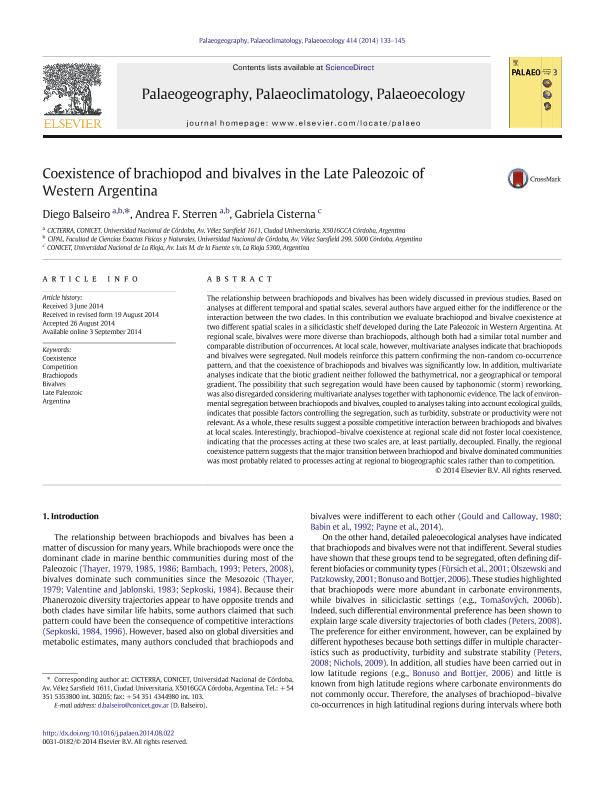Mostrar el registro sencillo del ítem
dc.contributor.author
Balseiro, Diego

dc.contributor.author
Sterren, Andrea Fabiana

dc.contributor.author
Cisterna, Gabriela Adriana

dc.date.available
2017-12-28T20:36:41Z
dc.date.issued
2014-09
dc.identifier.citation
Cisterna, Gabriela Adriana; Sterren, Andrea Fabiana; Balseiro, Diego; Coexistence of brachiopod and bivalves in the Late Paleozoic of Western Argentina; Elsevier Science; Palaeogeography, Palaeoclimatology, Palaeoecology; 414; 9-2014; 133-145
dc.identifier.issn
0031-0182
dc.identifier.uri
http://hdl.handle.net/11336/31897
dc.description.abstract
The relationship between brachiopods and bivalves has been widely discussed in previous studies. Based on analyses at different temporal and spatial scales, several authors have argued either for the indifference or the interaction between the two clades. In this contribution we evaluate brachiopod and bivalve coexistence at two different spatial scales in a siliciclastic shelf developed during the Late Paleozoic in Western Argentina. At regional scale, bivalves were more diverse than brachiopods, although both had a similar total number and comparable distribution of occurrences. At local scale, however, multivariate analyses indicate that brachiopods and bivalves were segregated. Null models reinforce this pattern confirming the non-random co-occurrence pattern, and that the coexistence of brachiopods and bivalves was significantly low. In addition, multivariate analyses indicate that the biotic gradient neither followed the bathymetrical, nor a geographical or temporal gradient. The possibility that such segregation would have been caused by taphonomic (storm) reworking, was also disregarded considering multivariate analyses together with taphonomic evidence. The lack of environmental segregation between brachiopods and bivalves, coupled to analyses taking into account ecological guilds, indicates that possible factors controlling the segregation, such as turbidity, substrate or productivity were not relevant. As a whole, these results suggest a possible competitive interaction between brachiopods and bivalves at local scales. Interestingly, brachiopod–bivalve coexistence at regional scale did not foster local coexistence, indicating that the processes acting at these two scales are, at least partially, decoupled. Finally, the regional coexistence pattern suggests that the major transition between brachiopod and bivalve dominated communities was most probably related to processes acting at regional to biogeographic scales rather than to competition.
dc.format
application/pdf
dc.language.iso
eng
dc.publisher
Elsevier Science

dc.rights
info:eu-repo/semantics/openAccess
dc.rights.uri
https://creativecommons.org/licenses/by-nc-sa/2.5/ar/
dc.subject
Coexistence
dc.subject
Competition
dc.subject
Brachiopods
dc.subject
Bivalves
dc.subject
Late Peleozoic
dc.subject
Argentina
dc.subject.classification
Meteorología y Ciencias Atmosféricas

dc.subject.classification
Ciencias de la Tierra y relacionadas con el Medio Ambiente

dc.subject.classification
CIENCIAS NATURALES Y EXACTAS

dc.title
Coexistence of brachiopod and bivalves in the Late Paleozoic of Western Argentina
dc.type
info:eu-repo/semantics/article
dc.type
info:ar-repo/semantics/artículo
dc.type
info:eu-repo/semantics/publishedVersion
dc.date.updated
2017-12-28T17:47:38Z
dc.journal.volume
414
dc.journal.pagination
133-145
dc.journal.pais
Países Bajos

dc.journal.ciudad
Amsterdam
dc.description.fil
Fil: Balseiro, Diego. Universidad Nacional de Córdoba. Facultad de Ciencias Exactas Físicas y Naturales. Centro de Investigaciones Paleobiológicas; Argentina. Consejo Nacional de Investigaciones Científicas y Técnicas. Centro Científico Tecnológico Conicet - Córdoba. Centro de Investigaciones en Ciencias de la Tierra. Universidad Nacional de Córdoba. Facultad de Ciencias Exactas Físicas y Naturales. Centro de Investigaciones en Ciencias de la Tierra; Argentina
dc.description.fil
Fil: Sterren, Andrea Fabiana. Consejo Nacional de Investigaciones Científicas y Técnicas. Centro Científico Tecnológico Conicet - Córdoba. Centro de Investigaciones en Ciencias de la Tierra. Universidad Nacional de Córdoba. Facultad de Ciencias Exactas Físicas y Naturales. Centro de Investigaciones en Ciencias de la Tierra; Argentina. Universidad Nacional de Córdoba. Facultad de Ciencias Exactas Físicas y Naturales. Centro de Investigaciones Paleobiológicas; Argentina
dc.description.fil
Fil: Cisterna, Gabriela Adriana. Consejo Nacional de Investigaciones Científicas y Técnicas; Argentina
dc.journal.title
Palaeogeography, Palaeoclimatology, Palaeoecology

dc.relation.alternativeid
info:eu-repo/semantics/altIdentifier/doi/http://dx.doi.org/10.1016/j.palaeo.2014.08.022
dc.relation.alternativeid
info:eu-repo/semantics/altIdentifier/url/http://www.sciencedirect.com/science/article/pii/S0031018214004398
Archivos asociados
